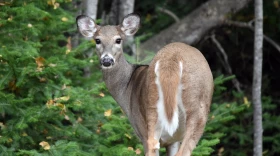Hello, welcome to High Plains Public Radio, this is Freddy Gipp, I’m an enrolled member of the Apache Tribe of Oklahoma and my indian name is “T’sa(N) T’hoop Ah(N)”, meaning Lead Horse in the Kiowa language.
I was born and raised in Lawrence, Kansas, where I graduated from the University of Kansas in 2016 with a degree in Strategic Communications from the William Allen White School of Journalism.
I currently run my own small consulting firm called Lead Horse LLC, which focuses on utilizing Native American Powwow celebrations as an effective economic driver for urban and rural communities.
I will be your book discussion leader for the 2018 National Book Award Finalist, “Where The Dead Sit Talking” by Cherokee author - Brandon Hobson.
In our previous discussions of “Where The Dead Sit Talking”, we introduced the story about a young Native American boy named Sequoyah living with his new foster family, Harold and Agnes Troutt, and their two foster children, Rosemary and George.
We dived into a few key themes such as displacement, with Sequoyah often finding himself in peculiar situations alone, late at night and wandering, to death and their infatuation and continuous references with the inevitable phenomenon.
But we must explore the most important theme of the book, in my opinion, which focuses around resilience. What does it mean to be resilient? A characteristic often associated with persistence, overcoming obstacles and conquering the most daunting tasks and feats. Who or what do we think of when we align our definition of resilience? The best thing about this question is there is no right answer. That’s for you to decide.
Our Native American people are the prime definition of resilience, based upon the history we have endured for centuries, we have constantly found a way to thrive, even in the most bleak periods of time such as the Indian Removal Act, Dawes Allotment Act, and the detrimental period of termination by the federal government in the mid-20th century, where they stripped many tribal nations of their federal recognition, thus “terminating” and assimilating into common society.
Sequoyah’s story is no different and abides by the simple narrative that you must keep going. You must continue to do what is necessary, otherwise you will get left behind. In his situation, living a life in which he doesn’t look forward to what other kids find exciting, develops his role of analyzing situations around him differently. His fascination with death and the darkness around it comes from his every-endearing love for Rosemary, which later became the bane of his existence.
Rosemary eventually ostracizes him shortly after returning from a multiple-day hiatus away from the Troutts, he is left with questions that only she can answer but refuses. Sequoyah became persistent and adamant about comforting Rosemary, never wanting to leave her side but much to her dismay, and when she committed suicide - he still didn’t give up.
Today, Native Americans, especially our youth, face some of the worst suicide rates in this country. While we are a minute population, equaling less than three percent of the entire population in this country, factors such as substance abuse, higher rates of poverty, unemployment and geographic isolation plays a huge part. It’s a sad and terrible thing, to get on social media and see yet another colleague, whether mutual or not, take their life and it has almost become a normality for many young Native Americans- which isn’t right. The conditions have worsened over the years for many tribes and have prompted leaders to counteract this epidemic.
This is Freddy Gipp and you are listening to High Plains Public Radio.







